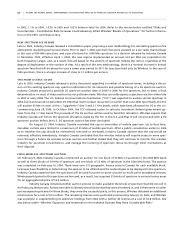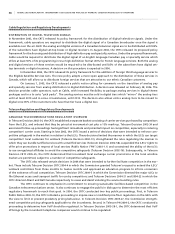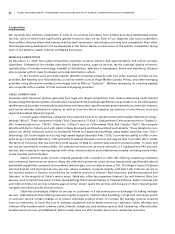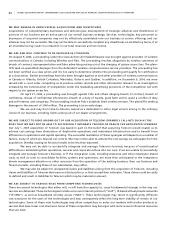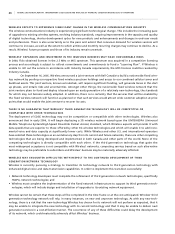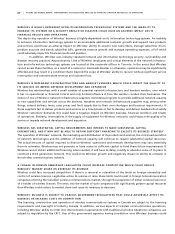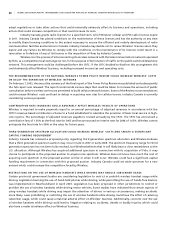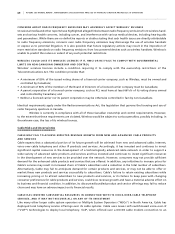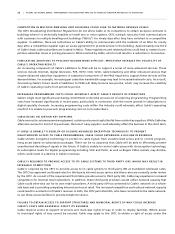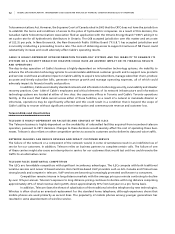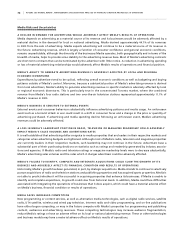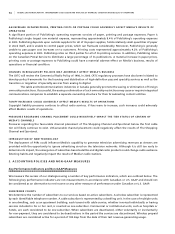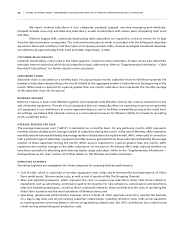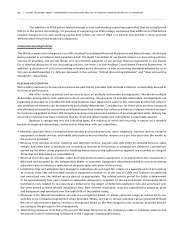Rogers 2005 Annual Report Download - page 71
Download and view the complete annual report
Please find page 71 of the 2005 Rogers annual report below. You can navigate through the pages in the report by either clicking on the pages listed below, or by using the keyword search tool below to find specific information within the annual report.
67 ROGERS 2005 ANNUAL REPORT . MANAGEMENT’S DISCUSSION AND ANALYSIS OF FINANCIAL CONDITION AND RESULTS OF OPERATIONS
WI R E LE S S I S H I GH L Y- D EP E N DE N T U PO N IT S I N FOR M AT I ON TEC H NO L OG Y SY S TE M S A ND T HE IN A B IL I TY TO
EN H A NC E I T S S Y ST E MS OR A S E CU R IT Y BR E AC H OR DI S AS T ER C OU L D H AVE AN AD V ERS E I M PA C T O N I T S
FI N A NC I AL RE S U LT S A N D O P ER A TI O NS
The day-to-day operation of Wireless’ business is highly-dependent on its information technology systems. An inability
to enhance information technology systems to accommodate additional customer growth and support new products
and services could have an adverse impact on Wireless’ ability to acquire new subscribers, manage subscriber churn,
produce accurate and timely subscriber bills, generate revenue growth and manage operating expenses, all of which
could adversely impact its financial results and position.
In addition, Wireless uses industry standard network and information technology security, survivability and
disaster recovery practices. Approximately 1,500 of Wireless’ employees and critical elements of the network infrastruc-
ture and information technology systems are located at the corporate offices in Toronto. In the event that Wireless
cannot access these facilities, as a result of a natural or manmade disaster or otherwise, operations may be significantly
affected and may result in a condition that is beyond the scope of Wireless’ ability to recover without significant service
interruption and commensurate revenue and customer loss.
WI R E LE S S I S D E PE N DE N T O N I N FR A ST R U CT U RE AND HA N DS E T V E ND O RS , WH I CH CO U LD I MP A CT T HE QU A LI T Y O F
IT S SE R VI C ES O R I MP E DE N ET W OR K D E V EL O PM E NT A ND EX P ANS I ON
Wireless has relationships with a small number of essential network infrastructure and handset vendors, over which
it has no operational or financial control and only limited influence in how the vendors conduct their businesses. The
failure of one of Wireless’ network infrastructure suppliers could delay programs to provide additional network capacity
or new capabilities and services across the business. Handsets and network infrastructure suppliers may, among other
things, extend delivery times, raise prices and limit supply due to their own shortages and business requirements. If
these suppliers fail to deliver products and services on a timely basis or fail to develop and deliver handsets that satisfy
Wireless’ customers’ demands, this could have a negative impact on Wireless’ business, financial condition and results
of operations. Similarly, interruptions in the supply of equipment for Wireless’ networks could impact the quality of its
service or impede network development and expansion.
WIR ELESS H AS SUBS TAN TIAL CA PITAL R EQU IREM ENT S AN D I NTE NDS TO MAKE SU BSTANTI AL CAPI TAL
EXP ENDITUR ES, AND IT MAY NO T BE AB LE TO O BTA IN S UFF ICI ENT FIN ANCI NG TO EXEC UTE ITS BU SINE SS STRATEG Y
The operation of Wireless’ network, the marketing and distribution of its products and services, the continued evolution
of network technologies and the addition of network capacity will continue to require substantial capital resources.
The actual amount of capital required to finance Wireless’ operations and network development may vary materially
from its estimates. Wireless may not generate or have access to sufficient capital to fund these future requirements. If
Wireless cannot obtain additional financing when needed, it will have to delay, modify or abandon some of its plans to
construct a third generation network. This could slow Wireless’ growth and negatively impact its ability to compete in
the wireless communications industry.
A C H AN G E I N F O RE I GN OW N E RS H IP LE G I SL A TI O N C O UL D I N CRE A SE CO M PET I TI O N W HIC H C O UL D RE D UC E
WI R E LE S S’ MA R K ET SH A RE O R D EC R EA S E I T S R EVE N UE
Wireless could face increased competition if there is a removal or relaxation of the limits on foreign ownership and
control of wireless licences. Legislative action to remove or relax these limits could result in foreign telecommunication
companies entering the Canadian wireless communications market, through the acquisition of either wireless licences or
of a holder of wireless licences. The entry into the market of such companies with significantly greater capital resources
than Wireless could reduce its market share and cause its revenues to decrease.
WI R E LE S S’ BU S I NE S S I S S U BJ E CT TO V AR I OU S GO V ER N ME N T R E GU L AT I ONS TH A T C OUL D A D VE R S EL Y A F FE C T I T S
BU S I NE S S O R I N CR E AS E C O S TS OR CO M P ET I TI O N
The licensing, construction and operation of wireless communications systems in Canada are subject to the licensing
requirements and oversight of Industry Canada. In addition, various aspects of wireless communications operations,
including Wireless’ ability to enter into interconnection agreements with traditional wireline telephone companies, are
subject to regulation by the CRTC. Any of the government agencies having jurisdiction over Wireless’ business could


